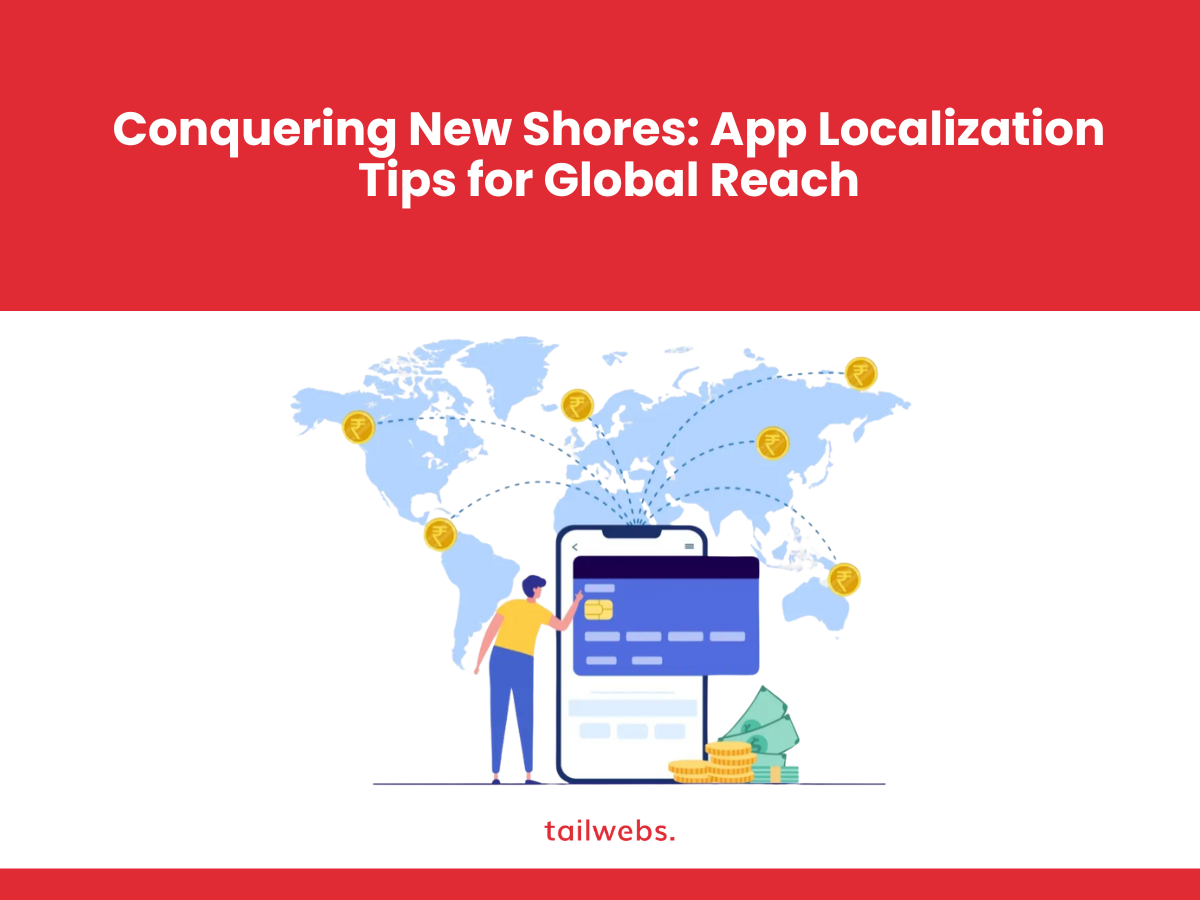In today’s hyper-connected world, your mobile app has the potential to transcend borders and captivate audiences across the globe. But simply releasing your app in another language isn’t enough. To truly conquer new markets and achieve global reach, you need to embrace app localization, tailoring your app experience to resonate with local cultures and languages.
The Untapped Potential of Global App Users:
The global mobile app market is expected to reach a staggering $766.4 billion by 2027, with emerging markets driving much of the growth.
72% of mobile app users prefer to use apps in their native language, highlighting the importance of localization.
By localising your app, you tap into a vast pool of potential users, boost brand awareness, and open doors to lucrative new markets.
Beyond Translation: The Essence of App Localization:
Localization goes beyond mere translation. It’s about adapting your app to the cultural nuances, user preferences, and technological realities of your target market. Here are key considerations:
1. Language and Cultural Adaptation:
Translate accurately and naturally:
Use native speakers and cultural experts to ensure translations are fluent, culturally appropriate, and avoid any faux pas.
Adapt UI/UX design:
Consider local colour palettes, iconography, and layout preferences to create a familiar and intuitive experience.
Format dates, currencies, and numbers: Follow local conventions for displaying dates, times, currencies, and measurement units.
2. Content and Marketing Optimization:
Localise marketing materials:
Adapt your app store descriptions, screenshots, and marketing campaigns to resonate with the local audience.
Incorporate culturally relevant references:
Use humour, idioms, and imagery relatable to your target market for a more engaging experience.
Adapt legal and privacy policies: Ensure compliance with local laws and regulations regarding data privacy and user agreements.
3. Technological Considerations:
Optimise for local devices and networks:
Consider screen sizes, operating system versions, and network speeds prevalent in your target market.
Offer local payment options:
Integrate popular payment methods used in your target region to ensure a seamless transaction process.
Support local customer service:
Provide customer support in the local language, addressing user concerns and building trust.
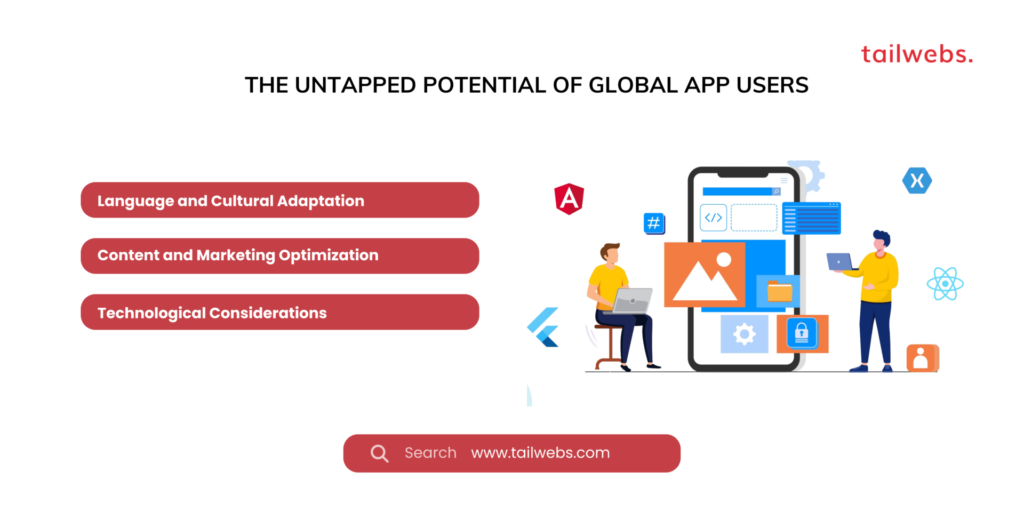
Case Studies: Localization Done Right:
Spotify:
By meticulously localising music recommendations, playlists, and marketing campaigns, Spotify has become a global music giant, conquering diverse markets.
Airbnb:
Offering localised listings, translations, and culturally relevant experiences has propelled Airbnb to a leading position in the travel accommodation market worldwide.
TikTok:
Adapting its content algorithms and user interface to local trends and preferences has made TikTok a cultural phenomenon across continents.
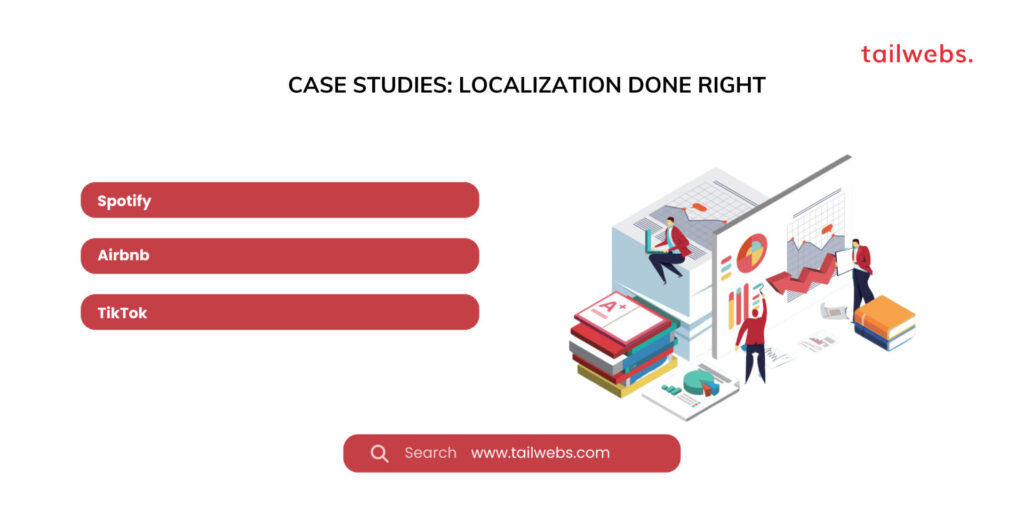
Navigating the Localization Journey:
Entering new markets through app localization can be exciting, but it also presents challenges:
Cost and resource investment:
Localization requires dedicated effort and resources, from translation teams to cultural consultants.
Maintaining consistency:
Keeping localised versions updated with new features and content can be an ongoing task.
Market research and understanding:
Thoroughly researching your target market and its cultural nuances is crucial for successful localization.
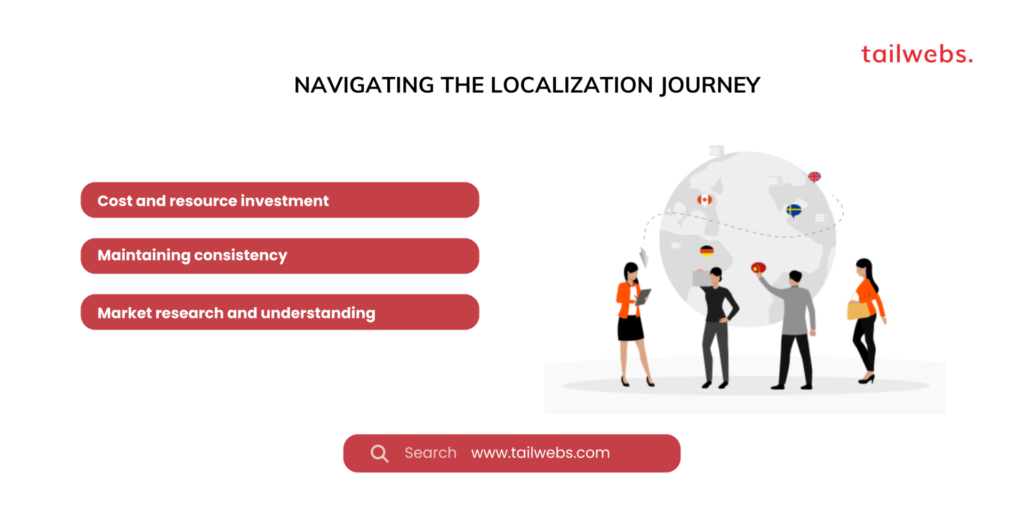
Tips for App Localization Success:
Start with a well-designed and documented app: A clean and modular app architecture facilitates smoother localization.
Prioritise key markets: Focus on regions with the highest potential for user base and revenue growth.
Choose the right partners: Collaborate with experienced localization agencies and native speakers to ensure accuracy and cultural sensitivity.
Test and iterate: Continuously test localised versions on real users to identify and address any issues.
Embrace cultural feedback: Be open to feedback from local users and iterate your app based on their preferences.
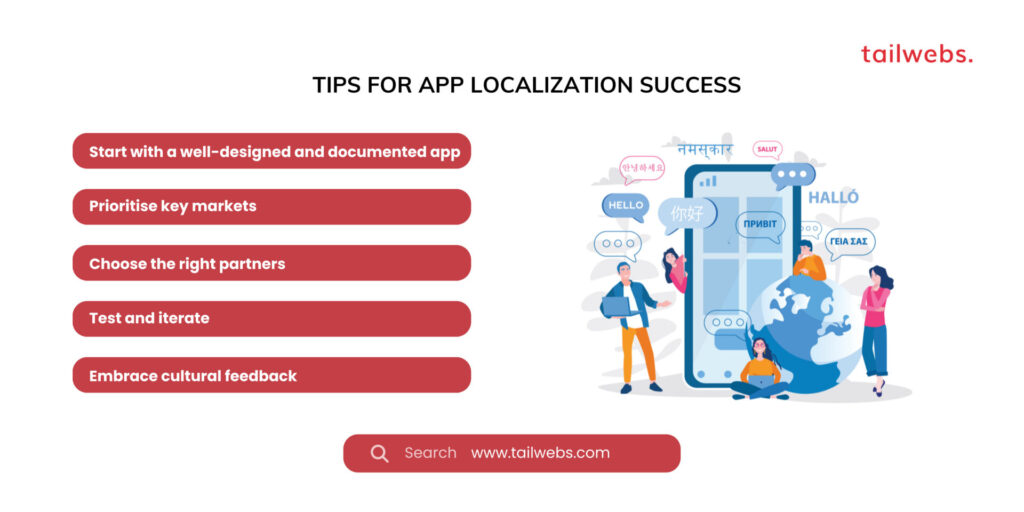
Unleashing the Power of Global App Reach:
By embracing app localization, you unlock a world of untapped potential. You connect with new audiences, expand your brand reach, and boost your app’s success on a global scale. Remember, it’s not just about translation; it’s about cultural understanding, adaptation, and a commitment to delivering a truly localised experience that resonates with users across the globe.
So, chart your course, set sail on the localization journey, and watch your app conquer new shores, leaving its mark on the minds and hearts of users worldwide. The vast digital ocean awaits, teeming with untapped possibilities – your app’s global voyage begins now.
Let’s continue the conversation! Share your experiences, tips, and questions about app localization in the comments below. Together, we can empower developers and unlock the true potential of app localization, connecting apps with users across every corner of the world.
Dive Deeper: Advanced Strategies for App Localization Mastery
We’ve explored the fundamentals of app localization and its potential to unlock global reach. Now, let’s delve deeper into advanced strategies for mastering this transformative art, ensuring your app resonates with diverse audiences across borders.
Going Beyond the Basics:
Hyper-Localization:
Instead of broad market localization, tailor your app to specific regions or subcultures within your target market. This involves nuances like adapting humour, references, and even UI elements to resonate with local preferences.
Transcreation:
When literal translation doesn’t capture the essence of your message or cultural context, transcreation comes into play. This creative approach reinterprets the original content while preserving its core message and adapting it to the target audience’s cultural context.
Right-to-Left Language Support:
For languages like Arabic or Hebrew, ensure your app’s layout, UI elements, and text direction are optimised for right-to-left reading. This goes beyond simple mirroring; it requires meticulous attention to detail to deliver a seamless experience.
Accessibility Considerations:
Remember to incorporate accessibility features like screen reader compatibility and visual aids when localising your app. This ensures inclusivity and caters to diverse user needs across your global audience.
Localization Testing and Optimization:
Thorough testing across different devices, operating systems, and network conditions is crucial for ensuring a smooth localised experience. A/B testing different UI elements and marketing messages can further optimise your app for each target market.
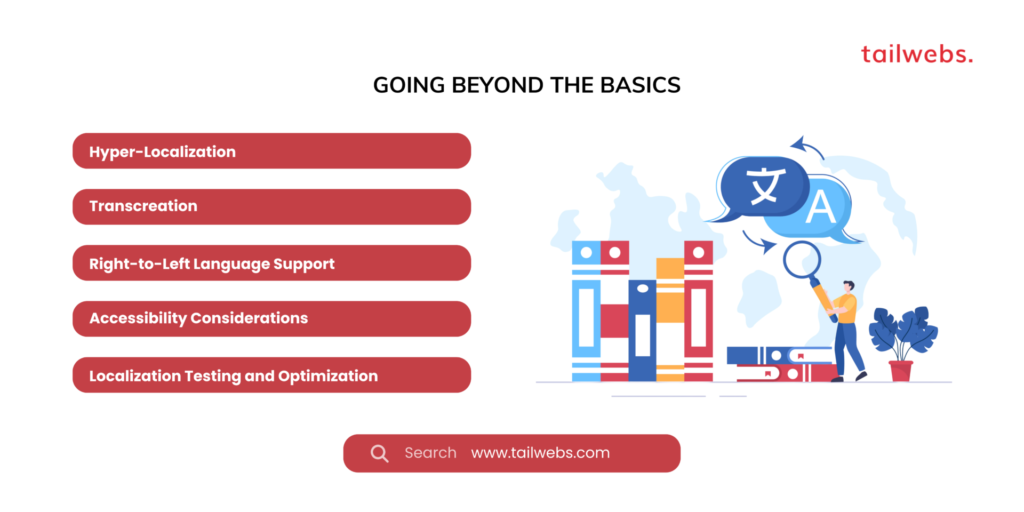
Tech-Powered Tools for Localization Success:
Embrace technology to streamline the localization process:
Machine Translation Tools:
Utilise machine translation engines for initial drafts, followed by human review and cultural adaptation for accuracy and nuance.
Localization Management Platforms (LMPs):
These platforms centralise the localization workflow, manage assets, and facilitate collaboration between developers, translators, and cultural consultants.
Global App Marketing Tools:
Leverage tools to localise app store descriptions, screenshots, and marketing campaigns for targeted reach in each market.
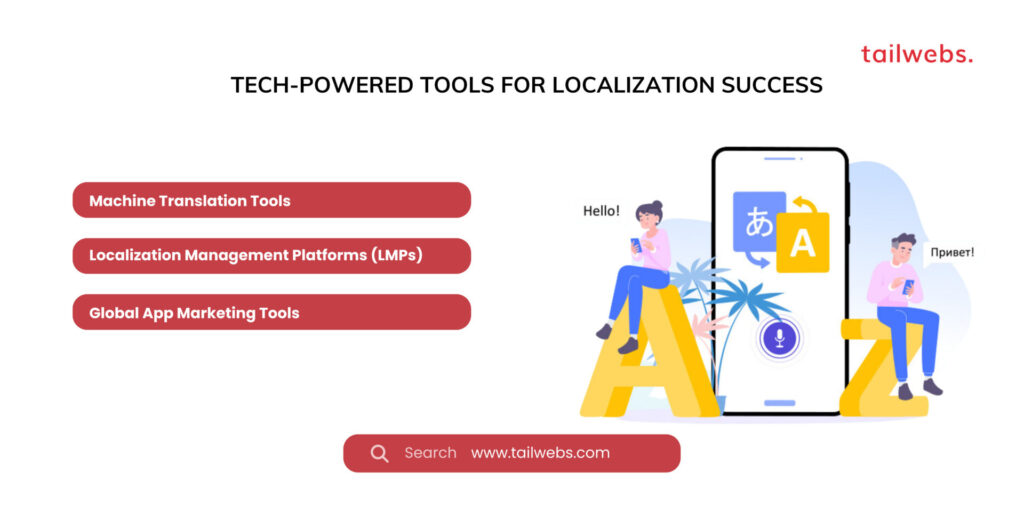
Building Cultural Bridges, One App at a Time:
App localization is not just a technical process; it’s a cultural bridge-building exercise. By understanding and respecting your target audience’s values, customs, and preferences, you can create an app that truly resonates with them.
Here are some additional tips for fostering cultural sensitivity:
Research local regulations and privacy policies:
Ensure compliance with data protection laws and user consent requirements in your target markets.
Embrace cultural feedback:
Actively solicit feedback from local users and iterate your app based on their suggestions and concerns.
Build partnerships with local influencers and media:
Collaborate with local influencers and media outlets to promote your app and reach new audiences in a culturally relevant way.
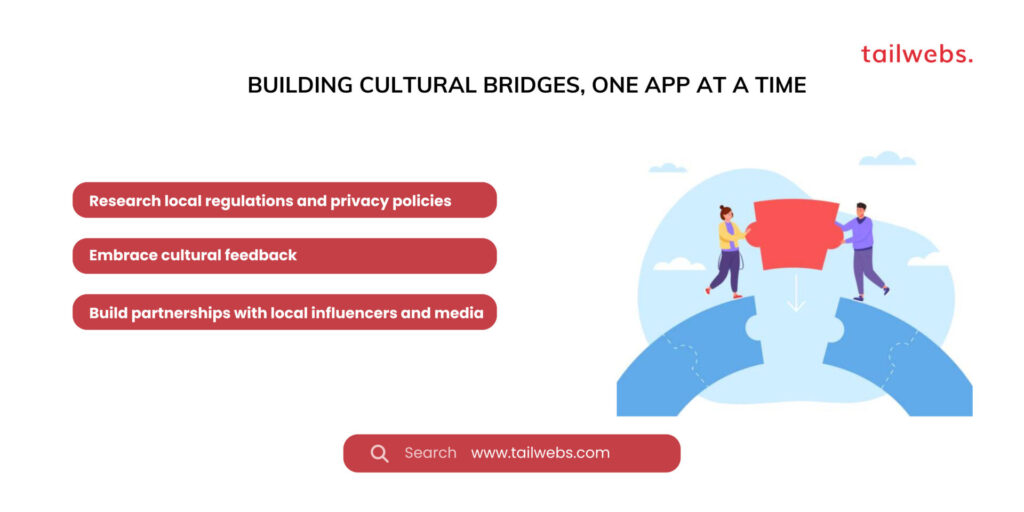
The Future of App Localization: AI, Personalization, and Beyond:
The future of app localization is brimming with exciting possibilities:
AI-powered localization:
Advanced AI algorithms will further automate translation and adaptation tasks, improving accuracy and efficiency.
Hyper-personalised experiences:
Localization will go beyond regional adaptation, catering to individual user preferences and contexts, delivering truly personalised app experiences.
Emergence of new markets and languages:
As technology advances and internet penetration increases, new markets and languages will emerge, requiring innovative localization solutions
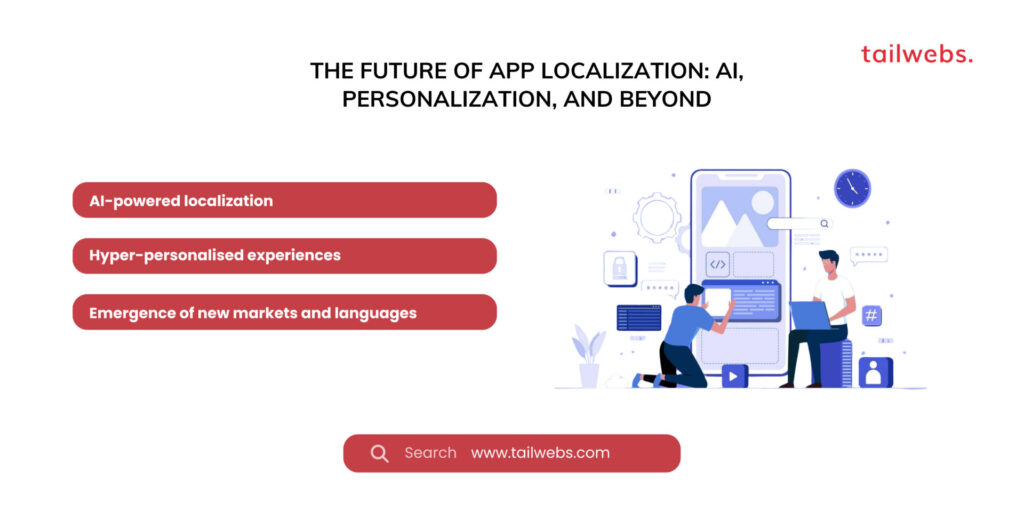
Embrace the Challenge, Reap the Rewards:
App localization is an ongoing journey, requiring continuous adaptation and cultural sensitivity. But the rewards are immense: global reach, loyal users, and a brand that resonates with diverse audiences across the world.
So, equip yourself with the right strategies, tools, and cultural awareness, and embark on this transformative journey. Remember, the future of app success lies in connecting with users across borders, and app localization is the key that unlocks the door to a global audience waiting to be captivated by your creation.
Let’s keep the conversation going! Share your thoughts, challenges, and successes in app localization in the comments below. Together, we can build a future where apps transcend language barriers and connect with users across the globe, fostering understanding, growth, and innovation in the ever-evolving world of mobile technology.

